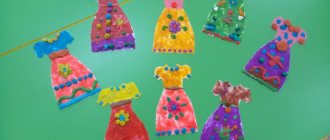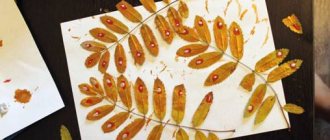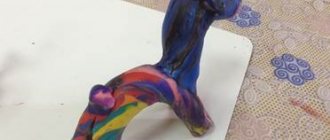Helpers from the Internet
Before you start sculpting a bird, you need to talk about it and be sure to show illustrations so that the children have a sample before their eyes. Just for this purpose you can use a set of educational cards “Birds”, which can be purchased in the online store “OZON.RU”. 20 large colorful pictures will help children expand their vocabulary, learn the names of birds, and develop photographic memory.
What else is needed to sculpt birds? It is clear that the material. In kindergarten we usually sculpt from plasticine, but it happens that we use other materials. An excellent choice on the same “Ozone”: plasticine of different colors and different manufacturers, modeling mass, dough, kinetic sand and the necessary accessories you can choose without getting up from your chair, as they say. All materials are certified, tested, and recommended for use in preschool, school and home settings.
Let's move on to books. “UchMag” offers a teaching method “Modeling in kindergarten with children aged 5-7 years”, which will help educators draw up a summary of a lesson on modeling, and active parents - in solving the problem of what to do with a child on a day off or during the holidays. In principle, additional cards with illustrations are not needed; the manual contains beautiful pictures.
The online store “Kniga.ru” presents two manuals on our topic: and. I like both books, I think they are worth purchasing for a teacher’s library to add something new to their methodology for planning developmental activities with preschoolers. The first manual is interesting because it shows how you can synthesize several types of arts (folk toys, small sculpture, drawing, music, artistic expression) in modeling classes.
Good notes, I recommend them.
And the second manual is more universal and is devoted not only to modeling, but also to appliqué and drawing. All classes are meaningful and interconnected; this is a whole system for the aesthetic development of preschoolers.
Abstract of GCD in the preparatory group on the topic “Migratory Birds” (modeling)
ABSTRACT
NODE ON ARTISTIC AND AESTHETIC DEVELOPMENT (STYLE)
ON THE TOPIC "MIGRATORY BIRDS"
Program content:
1. Expand and consolidate children’s ideas about migratory birds: cuckoo, nightingale, swallow, rook, starling;
about the body parts of birds. 2. Learn to sculpt a bird from plasticine using a plastic method, pulling out parts from a whole piece and in a constructive way, observing the location and relationship of body parts, connecting the parts, pressing them together. 3. Continue learning how to use the stack. 4. Develop the ability to work with your hands, fine motor skills of the fingers, eye, attention, memory, creative thinking. 5. Instill in children a kind attitude towards migratory birds and all living things in nature. Demonstration material:
illustrations of migratory birds, a swallow made of plasticine.
Handouts:
plasticine, stacks, modeling boards, rags, twigs.
Preliminary work:
bird watching while walking; conversation about migratory birds, reading stories about birds.
Progress of the lesson.
1. The teacher
invites the children to guess riddles: (5 min) 1. Who, without notes and without a pipe, is the best at trilling, more vocal, more tender? Who is this? ... (Nightingale)
2. She sits on a branch in the forest, She repeats one “peek-a-boo”, She counts the years for all of us, She loses her chicks. “Peek-a-boo” here and there, What is this bird’s name? (cuckoo)
3. Faithful guardian and friend of the fields, The first messenger of warm days. Blackens all migratory birds, cleans the arable land of worms. (rook)
4. On a pole is a cheerful house with a small round window. For the children to fall asleep, the house is rocked by the wind. The father is singing on the porch - He is both a pilot and a singer. (starling)
5. Flies to us with warmth, Having traveled a long way. Sculpts a house under the window from grass and clay. (martin)
Children
solve riddles.
Educator
exhibits illustrations depicting guessed birds.
The teacher
asks the children questions:
- What are the names of the birds that you guessed in the riddle? — Why are these birds called migratory? - Name all the migratory birds again?
Children
answer questions.
2. The teacher
makes a generalization and reports that the swallow sent a letter.
(2 min) (teacher shows the envelope).
Educator
offers to open the envelope, read and find out what the swallow writes.
(the teacher reads the letter).
| Hello guys! I hasten to write you a letter! I and my swallow friends were flying from a warm region. I was distracted from the flight, I wanted to see what nature looks like from a bird’s eye view, how I fell behind my friends. And now I’m alone and I don’t know what to do. Please help me find my friends! |
Educator
says that the swallow itself has arrived! It is not simple, but magical. The teacher offers to mold her swallow friends from plasticine so that she will not be bored and lonely, but first she suggests doing finger gymnastics.
3. Finger gymnastics (bend the fingers of both hands) (2 min) Sing, sing along, This bird is a crake, Ten birds are a flock, This bird is a starling, This bird is a sparrow, A gray feather. This bird is an owl, This one is a finch, A sleepy little head. This one is a swift, This bird is a waxwing, This one is a cheerful siskin. Well, this one is an angry eagle, Birds, birds, go home (hands behind your back).
4. Educator
invites the children to first look at the swallow.
(10 min) - What parts does a swallow consist of? (head, beak, eyes, body, wings, tail, paws). - What kind of tail does a swallow have? (forked). -What kind of wings does a swallow have? (wide). Children
look at the illustration of a swallow and note its structure and features.
Educator
informs the children that they are now starting to sculpt a swallow. From a piece of plasticine you need to separate a large one (for the body and tail) and 3 small pieces for the head and wings. From a small piece we roll a ball (the head, the beak should be pulled out with two fingers and made sharp, the eyes will be drawn in a stack. From a large piece we will roll an oval (the body, the tail should be pulled out with two fingers and the tail should be divided into two parts with a stack. This way we get a forked tail. U swallows have a white breast, for this, using a white cake, you need to make a white breast.
5. Exercise “Guess and sit down.” (2min) Teacher
invites children to stand up for a physical education session called “Guess and sit down.” The teacher names migratory and wintering birds; if he names the name of a wintering bird, then you need to sit down; and if the name is migratory, then wave your hands. Crow, nightingale, woodpecker, magpie, dove, swallow, tit, rook, starling, bullfinch, stork, crane, sparrow, heron, etc.
Children
take their seats.
6. Educator
reports that the work continues and wings are made from the remaining two pieces of plasticine.
The swallow has graceful, pointed wings, shaped like a comma. To do this, you need to roll out small ovals and flatten them on one side. The point of the stack will help create the illusion of feathers, you just need to make longitudinal furrows. Then connect all the parts. First attach the head to the body, and then the wings. The swallows are ready. (6 min) 7. The teacher
says that their swallows are ready and invites them to answer: - What did you do today?
(they sculpted swallows). —What were the swallows made of? (from dough) - Please tell us how you sculpted the swallows? Children
remember the work done.
Educator
notes that they made very good and beautiful swallows. The Swallow really liked her new friends. And now they will live, play and enjoy the warm sun together (3 min).
Literature.
Kazakova T. G. Develop creativity in preschoolers. – M.: Education, 1985. – p.181.








